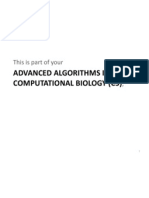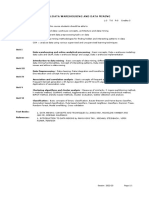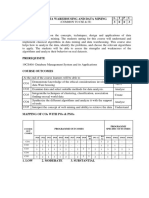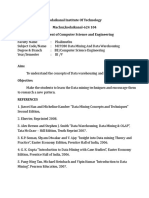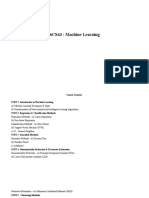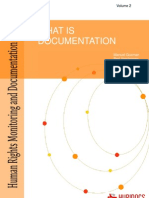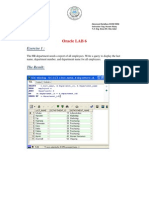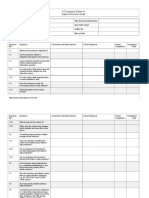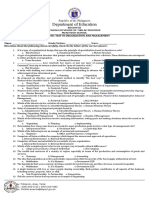231AD31 DATA ANAYTICS LTPC
30 0 3
Programme: B.Tech Artificial Intelligence and Data Science Sem: 3 Category: PC
Pre-/Co-requisite: Nil
Aim:
To impart knowledge about networks, algorithms, and programming skills to create
algorithms capable of human-like solutions.
Course Outcomes: The Students will be able to
CO1: Analyze the need of Data Analytics
Identify the components of data warehousing architecture
CO2:
CO3: Make use of Frequent Pattern Evaluation Methods
CO4: Demonstrate Regression techniques with the Data Sets
CO5: Apply and implement enhanced classification methods and other clustering techniques.
CO6: Plan recent trends of Data mining in business applications
UNIT I INTRODUCTION
Introduction to Data Analytics Overview of Data Analytics, Need of Data Analytics, Nature of Data,
Types of data and data Analytics- Characteristics of Data, Applications of Data Analytics.Business
Intelligence and Analytics, Business Analytics Optimization.
UNIT II DATAWAREHOUSING
Data warehousing - Data warehousing Components — Data Warehouse Modeling — Design and
implementation Mapping the Data Warehouse to Multiprocessor Architecture — Online Analytical
Processing and Tools — Data Cube Technologies — Multidimensional Data Analysis — Introduction
to KDD process — Knowledge discovery from databases — Data mining functionalities —
Technologies used — Applications
UNIT III FREQUENT PATTERN MINING TECHNIQUES
Knowing Data: Data Sets, Data objects and attributes — Statistical description of data —Measuring
similarity and dissimilarity —Mining frequent item sets: Apriority algorithm, FP Growth Tree —
Frequent Pattern evaluation methods — Support, Confidence, Association Mining various kinds of
association rules
Regression techniques: Linear Regression: Least Square Regression — Logistic — other regression
types —— k Nearest Neighbour — Decision tree induction: ID3, C4.5, CART — Bayesian
classification: Naïve Bayes — Model Evaluation and Selection: Accuracy, AUC, Error rate,
Sensitivity, Specificity, Precision, Recall — Cross validation — Confusion Matrix-Clustering
techniques: Partitioning methods — kMeans — kMeans++ — kMedoids — Hierarchical methods —
Agglomerative Clustering – Dendrogram Evaluation of clustering algorithms — DBSCAN
UNIT V CASE STUDY
Mining Complex Data Types — Sequential pattern mining in symbolic sequences, Customer
Segmentation for Retail- Data mining for intrusion detection and prevention - Data mining and
Recommender systems.
TEXT BOOK:
Jiawei Han and Micheline Kamber, “Data Mining: Concepts and Techniques”, Morgan Kaufmann
Publishers, Third edition, 2011
REFERENCE BOOK:
�1.G. K. Gupta, “Introduction to Data Mining with Case Studies”, Prentice Hall of India, Easter
Economy Edition, 2014
2. Alex Berson and Stephen J. Smith, “Data Warehousing, Data Mining & OLAP”, Tata McGraw Hill
Edition, 21st Reprint, 2011.Nitin Gaur et aI.”Hands-On Blockchain with Hyperledger” June
2018,.Packt publisher





























